1 Introduction
Different types of diodes that are used in many applications, sucha as Zener, Schottky, Semiconductor, PN junction, LED, Varactor, Gun, PIN and Tunnel diode, etc. This article is introducting these types of diode from different aspects. It is easy and comprehensive tutorial for the electronic study.
1.1 Diode Structure and Symbol
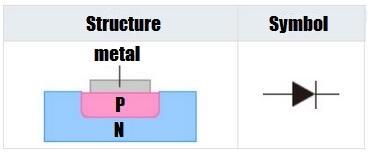
Figure 1. Simple Diode Structure and Symbol
Basic diode consist of a tube, a case and two electrodes. The tube is a PN junction, and a pin is drawn at each end of the PN junction. Use plastic, glass, or metal material to make a package shell, as shown in the following figure. The electrode drawn out of the P area is called a positive electrode or anode, and the electrode drawn out of the N area is called a negative electrode or cathode.
1.2 Classification Standard
1) According to the material, it can be divided into germanium diode (Ge tube) and silicon diode (Si tube).
2) According to the structure, it can be divided into point-contact diodes, surface-contact diodes and planar diodes. The point-contact diode has a small PN junction and cannot pass through a large forward current and withstand a high reverse voltage. However, it has good performance in high-frequency and is suitable for high-frequency detection circuits and switching circuits. The surface-contact diode has a large PN junction, can pass a large current and withstand a high reverse voltage, and is suitable for use in a rectifier circuit. When the planar diode is used as a switching tube in a pulse digital circuit, the PN junction contact is small, but the PN junction area is large when used for high-power rectification. There are two types of SMD diodes, leaded and leadless, and their common shapes are cylindrical and rectangular.
3) According to use: include rectifier diode, detection diode, zener diode, varactor diode, photodiode, light emitting diode, switching diode, fast recovery diode, etc.
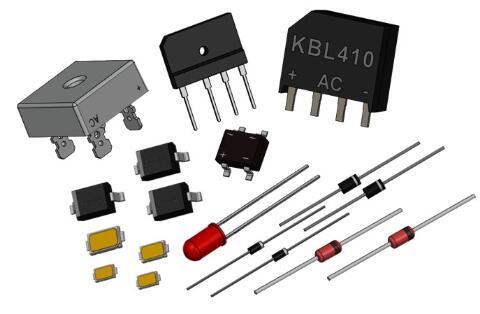
2 Common Diodes Description
1) Rectifier Diodes
Rectifier diodes can rectify AC power into pulsating DC power using the unidirectional conductivity characteristics. Because the forward current of the rectifier diode is relatively large, the structure always adopt to the surface-contact type. But this structure will cause a large junction capacitance. Generally, the operating frequency of the rectifier diode is less than 3KHz. Fully sealed metal structure packaging and plastic packaging are common for rectifier diodes. The rectifiers with a forward rated current of more than 1A are packaged in a metal shell to dissipate heat fully; the rectifiers with a forward rated current of less than 1A are mostly packaged with full plastic.

Figure 2. Rectifier
When selecting a rectifier diode, the parameters such as its maximum rectified current, maximum reverse operating current, cut-off frequency and reverse recovery time are mainly considered. The rectifier tube used in the common series stabilized power supply circuit, its reverse recovery time of the cut-off frequency is not strict, therefore, only the maximum rectification current and the maximum reverse working current that meets circuit requirements can be selected. In addition, the rectifier circuit of the switching power supply and the pulse rectifier circuit should use rectifiers with high operating frequency and short reverse recovery time.
2) Detection Diodes
The detection diode is a device that filters out the low-frequency signal superimposed on the high-frequency carrier. It has high detection efficiency and good frequency characteristics, and mostly uses a glass packaging structure. The detection diode has the characteristics of small forward voltage drop, high detection efficiency, small junction capacitance, and good frequency characteristics. When selecting a detection diode, high operating frequency, small reverse current, and sufficiently large forward current should be considered according to the circuit design requirements.
3) Switching Diodes
The forward bias on-resistance of the switching diode is very low under, and the off-resistance is very large when the reverse bias is applied. Using the unidirectional conduction characteristics of the diode, the current can be turned on and off, so the tube is called a switching diode.
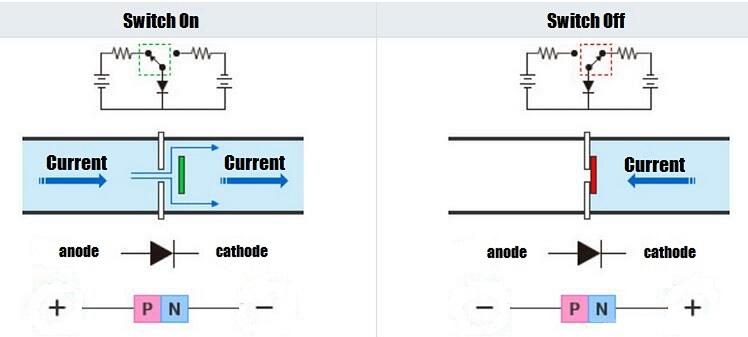
Figure 3. Switching Diode
Medium-speed switch circuit and detector circuit can use 2AK series ordinary switch diode. High-speed switching circuit can choose RLS series, 1S series, 1N series, 2CK series high-speed switching diodes. The specific model of the switching diode should be selected according to the main parameters of circuits, such as forward current, maximum reverse voltage, reverse recovery time, etc. For example, the reverse recovery time (trr) refers to a time from the on-state to the fully off-state. Generally, the electron cannot be stopped immediately after being turned off, and a certain amount of reverse current flows, and the greater the leakage current, the greater the loss. The key characteristic of the switching diode is the fast on/off speed, which can meet the needs of high-frequency and ultra-high-frequency circuits. So it is often used in pulse digital circuits and automatic control circuits.
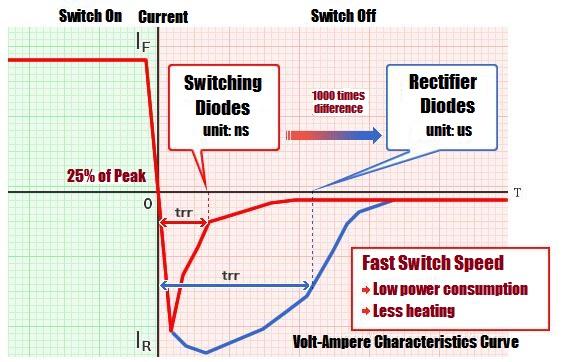
Figure 4. Reverse Recovery Time (trr)
4) Zener Diodes
Zener diodes achieve the purpose of voltage regulation according to the characteristic that the voltage basically does not change with the change of current when the PN junction reverses breakdown. It is divided according to the breakdown voltage, and its voltage regulation value is the breakdown voltage value. As a voltage regulator or voltage reference component, zener diodes can be connected in series to obtain a higher voltage regulation value. When selecting, the zener diode should comply with the circuit parameter requirements. For example, the stable voltage value of the zener diode should be the same as the reference voltage of the application circuit, and the maximum stable current should be higher around 50% than the maximum load current of the application circuit.
5) Avalanche Diodes
The avalanche diode is a microwave power device drew up on the basis of the voltage regulator technology. It can produce high-frequency oscillation under the effect of an external voltage. Avalanche diodes use avalanche breakdown to inject carriers into the crystal. Because the carrier takes a certain amount of time to travel across the semiconductor wafer, its current lags the voltage for a while. If the transit time is properly controlled, there will be a negative resistance effect on the current-voltage relationship, resulting in high-frequency oscillations. As for application, It is often used in microwave communications, radar, tactical missiles, remote control, telemetering, and other equipment.
6) Fast Recovery Diodes
The fast recovery diode is a new type of semiconductor diode, which has sound switching characteristics and short reverse recovery time, and is usually used as a rectifier diode in high-frequency switching power supplies.
The reverse recovery time is an important parameter for fast recovery diode. The definition of it is the time required for the diode to change from the forward on state to the cut-off state quickly, from zero output pulse to the reverse power supply to recover to 10% of the maximum reverse current.
Super fast recovery diodes (SRD) are developed on the basis of fast recovery diodes, and their principal difference is that the shorter reverse recovery time. The reverse recovery time of an ordinary fast recovery diode is several hundred nanoseconds, and is generally several tens of nanoseconds for a SRD. The smaller the value, the higher the working frequency of diodes. When the operating frequency is in the range of tens to hundreds of kHz, the time for voltage changes of the ordinary rectifier diode is slower than the recovery time, and diodes cannot work normally based on unidirectional conduction. In this case, a fast recovery rectifier diode is required. Therefore, rectifier diodes used in switching power supplies for color TVs and other household appliances. Otherwise, electrical appliances may not work properly with ordinary rectifier diodes.
7) Step Recovary Diodes
Its structural characteristics are: a steep impurity distribution area at the boundary of the PN junction, thereby forming a "self-help electric field". Because the PN junction is under forward bias, it conducts with a small number of carriers, and has a charge storage effect near the PN junction, so that its reverse current needs a "storage time" before it can fall to the minimum (reverse saturation current value). The self-help electric field shortens the storage time, cuts off the reverse current quickly, and generates rich harmonic components. Utilizing these harmonic components, a special spectrum generating circuit can be designed, which mainly used in pulse and higher harmonic circuits.
8) Schottky Diodes
Schottky diode is a low-power, high-current, ultra-high-speed semiconductor device, its reverse recovery time is extremely short (can be as small as a few nanoseconds), the forward voltage drop is only about 0.4 V, but the rectified current can reach thousands of amps. These excellent characteristics are unmatched by fast recovery diodes.
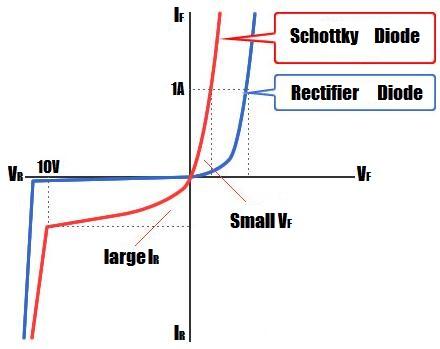
Figure 5. V-I Curve
Schottky diode is a metal-semiconductor device made of precious metal (gold, silver, aluminum, platinum, etc.) as the positive electrode, and N-type semiconductor as the negative electrode, and the barrier formed on the contact surface of the two has rectifying characteristics. Schottky diodes are usually used in high-frequency, high-current, low-voltage rectifier circuits. In addition, some switching power supplies require it.
9) Transient Voltage Suppressor (TVS)
Transient voltage suppressor(TVS) is a commonly used circuit protection device, and has fast response time (sub-nanosecond level) and a fairly high surge absorption capacity. As its two ends are subjected to an instantaneous high-energy impact, the TVS can change the impedance value between the two ends from a high impedance to a low impedance at a very high speed to absorb an instantaneous large current and clamp the voltage on a predetermined value, to protect the subsequent circuit components from transient high voltage spikes. Its response to overvoltage is faster than the varistor or gas discharge tube. It is widely used in computers, electronic instruments, communication equipment, household appliances, and airborne/marine and automotive electronic equipment, also it can be used as a protective element such as overvoltage shock or lightning strikes.
TVS can be divided into four categories according to their peak pulse power: 50W, 1000W, 1500W, and 5000W. It will turn on instantaneously when the voltage at both ends is higher than the rated value, and the resistance at both ends will change from high resistance to low resistance at a very high speed, absorbing a huge current and clamping the voltage at a predetermined value across the tube.
10) Light Emitting Diodes (LED)
The light-emitting diodes are made of semiconductor materials such as gallium phosphide and gallium arsenide phosphide. In addition to the unidirectional conductivity characteristic of ordinary diodes, they can directly convert electrical energy into light energy. When a forward voltage is applied to the light-emitting diode, it is also in a conducting state. A forward current flows through the tube, it will emit light.
The light-emitting color of the light-emitting diode is mainly determined by the material of the tube and the type of impurities incorporated. At present, the common light-emitting diodes have blue, green, yellow, red, orange, white and so on. The working current of the LED is usually 2~25mA. The operating voltage varies with different materials: ordinary green, yellow, red, and orange light-emitting diodes are about 2v; the operating voltage of white light-emitting diodes is usually higher than 2.4V, and the operating voltage of blue light-emitting diodes is usually higher than 3.3V. The working current of the LED cannot exceed the rated value, otherwise, there is a risk of burning. Therefore, a current limiting resistor is usually connected in series in the LED circuit. Infrared light-emitting diode is a special light-emitting diode, its shape is similar to LED, but it emits infrared light, which is invisible to human eyes under normal circumstances. Their working voltage is about 1.4V, and the working current is generally less than 20mA. In addition to single-color LEDs, there are two-color and three-color LEDs that can emit more than two colors of light.
The PN junction of the light-emitting diode is packaged in a transparent plastic shell, and the shape is square, rectangular and round. Light-emitting diodes have the advantages of low driving voltage, small working current, strong anti-vibration and impact capabilities, small size, high reliability, power saving and long life, thus they are commonly used in circuits such as signal indication.
11) Laser Diodes
Laser diodes are a type of diode similar to LEDs. They have similar characteristics to diodes, but in forward bias mode, they emit light and the voltage drop across ends acts as a load. The laser diode has the advantages of high efficiency, small size and long life, but its output power is small (generally less than 2mW). Their linearity is poor, also monochromaticity is not very good, so its application in the cable TV system is greatly restricted and cannot transmit multichannel and high-performance analog signals.
There are two common laser diodes:
①PIN photodiode
When it receives power to generate photocurrent, it will bring quantum noise.
② Avalanche photodiode
It can provide internal signal amplification, and the transmission distance is longer than the PIN photodiode, but its quantum noise is greater.
12) Photodiodes
The shell of a photodiode is equipped with a glass window to facilitate receiving light. Its characteristic is that when light is irradiated to its PN junction, free electrons and holes can be generated in pairs, so that the concentration of minority carriers in the semiconductor is increased. Under a certain reverse bias voltage, the reverse current increases. Therefore, its reverse current increases linearly with increasing light intensity. When there is no light, the volt-ampere characteristics of the photodiode are the same as ordinary diodes. As a light control element, the photodiode can be used for various object detection, photoelectric control, automatic alarm, etc. When a large photodiode is made, it can be used as an energy source called a photovoltaic cell. At this time, it does not need an external power supply, and can directly convert light energy into electrical energy.
13) Diode for Alternating Current (DIAC)
The DIAC is a diode that conducts electrical current only after its breakover voltage has been reached momentarily. It is a silicon bidirectional voltage trigger switching device. When the voltage applied across the diode exceeds its breakdown voltage, the two ends are turned on, and the conduction will not stop until the current is interrupted or it drops to the minimum of the holding current of the device. DISC is usually used in overvoltage protection circuits, phase shift circuits, thyristor trigger circuits, and timing circuits.
14) Varicap or Varactor Diodes
Varactor diodes are special semiconductor devices that use reverse bias to change the capacitance of a PN junction. It is equivalent to a variable-capacity capacitor. The capacitance of the PN junction between its two electrodes changes with the magnitude of the reverse voltage applied to the two ends. As the voltage increases, the capacity of the varactor diode decreases. Owing to this characteristic, it is mainly used in electric tuning circuits (such as the LNB of color TV sets), as an automatic fine-tuning capacitor controlled by voltage.
When choosing a varactor diode, it should be focused on operating frequency, maximum reverse operating voltage, maximum forward current, and zero bias junction capacitancc in the circuit. The varactor diode with low revere leakage current and various junction capacitance should be selected.
15) Freewheeling Diodes
Generally, a fast recovery diode or a Schottky diode is selected as a "freewheeling diode". It is generally used in the circuit to protect the component from breakdown by induced voltage or burned out. Connect in parallel to the two ends of the element that generates the induced electromotive force(EMF), and forms a loop with it, so that the high EMF generated in the loop is consumed by the current, thereby protecting the components in the circuit.
Freewheeling diodes are often used with energy storage elements to prevent sudden changes in voltage and current, and provide a path. The inductor can provide a continuous current to the load through it, so as to prevent the load current from abruptly changing and play a role in smoothing current. In the switching power supply, a freewheeling circuit composed of diodes and resistors connected in series. The freewheeling diode of this circuit is connected in parallel with the transformer. When the switching tube is turned off, the freewheeling circuit can release the energy stored in the transformer coil to prevent the induced voltage from being too high to damage the switch tube. In fact, freewheeling diode is not a substantial component, it is just having freewheeling function in the circuit.
16) Gunn Diode
Gunn diode, also called transferred electron device (TED), is a form of diode used in high-frequency electronics. Unlike ordinary diodes that have both a N-type region and a P-type region, it consists of N-type impurity semiconductor only.
The Gunn diode has three regions: the two ends are N-type impurity doped regions, and there is a lightly doped thin layer between them. When a voltage is applied across the Gunn diode, electrical gradients at the central thin layer are the largest. Because in the conductor material, the current is proportional to the voltage, conductivity will be generated. Eventually, a higher electric field value will be generated at the central thin layer, resulting in a higher resistance to prevent further increase in conductivity, thus the current will start to decrease. This means that the Gunn diode has a negative resistance effect, or called negative differential resistance. It is commonly used to generate microwave signals and has been used as a simple and effective form of microwave generator in many RF circuit designs.
17) Tunnel Diodes
It is a crystal diode with a tunneling current as the main current, and is a two-terminal active device. The base materials are gallium arsenide and germanium. The N-type region and the P-type region is highly doped (ie, with a high concentration of impurities). The tunneling current is produced by the quantum mechanical effect of semiconductors, which has the following three conditions: the conduction band and the full band are Fermi level; the width of the space charge layer must be narrow (below 0.01 microns); the holes in the P-type and N-type regions of will overlap with electrons at the same energy level. Tunnel diodes can be used in high-frequency amplifiers with low noise and high-frequency oscillators (whose operating frequency can reach the millimeter), and can also be used in high-speed switching circuits.
18) PIN Diodes
This is a crystal diode with a layer of intrinsic semiconductor (or semiconductor with low concentration of impurities) between the P region and the N region. When its operating frequency exceeds 100MHz, due to the storage effect of minority carriers and the transit time effect in the intrinsic layer, diode loses rectifying function and becomes an impedance element, and its impedance value varies with the bias voltage. Therefore, the PIN diode can be used as a variable impedance element. It is often used in high-frequency switches such as microwave switches, phase-shifting, modulation, amplitude limit and other circuits.
19) Damper Diodes
Damper diode has a lower voltage drop and a higher operating frequency, can withstand a higher reverse operating voltage and peak current, and has a small forward voltage drop. It is similar to a high-frequency high-voltage rectifier diode, and used for damper and booster rectification.
20) Vacuum Diodes
Vacuum diode, also called electron diode or valve, or vacuum tube. A tube with only one cathode and one anode. It is conducted by the electron emitted by the cathode based on heated filament. Because the filament has heat loss, the performance is poor than that of the semiconductor diode.
When the anode potential is higher than the cathode, the electrons emitted by the cathode move to the anode to form an electron flow under the action of the electric field. When the cathode voltage is higher than the anode, the electric field force received by the electrons pulls the electrons back to the cathode, and cannot generate current. That is unidirectional conductivity. It is generally used for rectification and detection. There are two types of vacuum tube, vacuum and gas (filled with an inert gas). The latter can also be used for voltage stabilization, indication and system control.
3 Diodes Comparison
3.1 Schottky Diode vs Common Diode
For common diode, the initial conduction voltage drop of the silicon tube is about 0.5V, the normal conduction voltage drop is about 0.7V, the conduction voltage drop is about 1V when it is close to the limit current. The initial conduction voltage drop of the germanium tube is about 0.2V, the normal turn-on voltage drop is about 0.3V, and the turn-on voltage drop is about 0.4V when it is close to the limit current. For Schottky diode, the initial turn-on voltage drop is about 0.4V, the normal turn-on voltage drop is about 0.5V, and the turn-on voltage drop is about 0.8V when it is approaching limit current.
Both diodes are unidirectional and can be used in rectification applications. The difference is that the withstand voltage of common silicon diodes can be higher, but its recovery time is long, and it can only be used for low-frequency rectification. If it is used in high frequency, reverse leakage will occur to cause tube burned. Withstand voltage of Schottky diode is low, but its recovery time is short and can be used in high frequency occasions.
3.2 Transient Voltage Suppressor vs ESD Protection Diode
TVS is mainly for transient voltage suppression, and ESD is mainly used for electrostatic discharge protection. As for anti-static, it requires low capacitance value, generally between 1 ~ 3.5PF is the best, ESD meets the requirements well. However, TVS cannot do this, because the capacitance of TVS is relatively high.
3.3 Light Emitting Diode vs Laser Diode
LED uses the spontaneous emission of carriers injected into the active area to emit light, while LD emits light from laser radiation. The direction of the light emitted by the LED is random, and the LD light is in the same direction and phase. The LD has an optical resonant cavity, so that the generated photons oscillate and amplify in the cavity, and the LED has no that. The LED has no critical value, the spectral density is several orders of magnitude higher than that of the LD, the LED light output power is small, and the divergence angle is large. LEDs are commonly used in the indicator light of electrical equipment such as traffic lights. They have the characteristics of long service life and high photoelectric conversion efficiency. While LD is widely used in low-power photoelectric devices such as CD drives on computers and print part of laser printers.
4 Diode Application
4.1 Rectification
According to the unidirectional conductivity, a diode can transform the alternating current into a pulsed direct current with a single direction.
4.2 Switch
Under the action of forward voltage, the resistance of the diode is very small, it is in the on state, which is equivalent to a switch on; under the action of the reverse voltage, the resistance is large, and it is in the off state, just like a switch off. Using the switching characteristics of the diode, various logic circuits can be made.
4.3 Amplitude Limit
After the diode is forward-conducted, its forward voltage drop remains basically the same (0.7V for silicon tube and 0.3V for germanium tube). Using this feature, diode often regarded as a limiting element in the circuit to limit the signal amplitude to a certain range.
4.4 Freewheeling Role
It plays a freewheeling role in the inductance of the switching power supply and inductive loads such as in relays.
4.5 Display
Diodes are commonly used in VCD, DVD, traffic lights and other displays.
